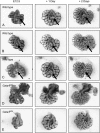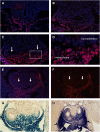Gata4 is necessary for normal pulmonary lobar development
- PMID: 17142311
- PMCID: PMC1899327
- DOI: 10.1165/rcmb.2006-0211RC
Gata4 is necessary for normal pulmonary lobar development
Abstract
Mutations of Fog2 in mice result in a phenotype that includes pulmonary lobar defects. To determine whether formation of the accessory lobe bronchus is mediated by a Gata family cofactor, we evaluated embryonic lungs from mice carrying missense mutations that cause loss of FOG-GATA protein interaction. Lungs from embryos carrying a missense mutation in Gata6 were structurally normal, while lungs from embryos carrying mutations of either Gata4 or of both Gata4 and Gata6 had a structural phenotype that matched the Fog2 mutant phenotype. Expression analysis showed that Gata4 and Fog2 are expressed in the ventral and medial pulmonary mesenchyme during secondary budding. Although Gata4 has not previously been suspected as playing a role in lung development, we have found that a Fog2-Gata4 interaction is critical for the development of normal pulmonary lobar structure, and this phenotype is not influenced by the additional loss of Gata6 interaction. Fog2 and Gata4 in the early pulmonary mesenchyme participate in patterning the secondary bronchus of the accessory lobe.
Figures




References
-
- Perl AK, Hokuto I, Impagnatiello MA, Christofori G, Whitsett JA. Temporal effects of Sprouty on lung morphogenesis. Dev Biol 2003;258:154–168. - PubMed
-
- Grindley JC, Bellusci S, Perkins D, Hogan BL. Evidence for the involvement of the Gli gene family in embryonic mouse lung development. Dev Biol 1997;188:337–348. - PubMed
-
- Cantor AB, Orkin SH. Coregulation of GATA factors by the Friend of GATA (FOG) family of multitype zinc finger proteins. Semin Cell Dev Biol 2005;16:117–128. - PubMed
-
- Huggins GS, Bacani CJ, Boltax J, Aikawa R, Leiden JM. Friend of GATA 2 physically interacts with chicken ovalbumin upstream promoter-TF2 (COUP-TF2) and COUP-TF3 and represses COUP-TF2-dependent activation of the atrial natriuretic factor promoter. J Biol Chem 2001;276:28029–28036. - PubMed
Publication types
MeSH terms
Substances
Grants and funding
LinkOut - more resources
Full Text Sources
Molecular Biology Databases

